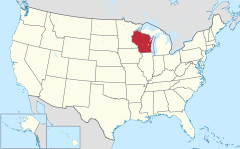2016 United States Elizabethkingia outbreak Disease outbreak in the United States
This article needs to be updated . Please help update this article to reflect recent events or newly available information. (January 2018 )
2016 United States Elizabethkingia anophelis outbreak Wisconsin, in red, the location of 63 confirmed cases as of June 16, 2016
Date November 1, 2015 (2015-11-01 ) — present Location Wisconsin , western Michigan , and Illinois , United States[ 1] [ 2] Type Disease outbreak Cause Elizabethkingia anophelis
Cases / Deaths (as of June 16, 2016) [ 3] [ 2] Wisconsin: 63 / 18
Michigan: 1 / 1
Illinois: 1 / 1 Deaths 20[ 3]
An outbreak of Elizabethkingia anophelis [ 4] [ 5] [ 6] [ 7] [ 1] [ 2]
History
As of March 2016, it was reported to be the largest outbreak of Elizabethkingia anophelis investigated by the Centers for Disease Control and Prevention (CDC).[ 8]
Human infections by E. anophelis involve the bloodstream.[ 4] cellulitis .[ 4] [ 4]
Statewide surveillance of the situation in Wisconsin was organized on January 5, 2016.[ 9] Columbia , Dane , Dodge , Fond du Lac , Jefferson , Milwaukee , Ozaukee , Racine , Sauk , Sheboygan , Washington , Waukesha , and Winnebago Counties); Illinois; and western Michigan as of April 13, 2016.[ 9] [ 1]
Between November 1, 2015 and March 30, 2016, 62 cases of E. anophelis infections were reported to the Wisconsin Department of Health Services, Division of Public Health.[ 4]
The severity of the outbreak is reflected in a statement by the CDC that "the agency sees a handful of Elizabethkingia infections around the country each year, but the outbreaks rarely involve more than a couple of cases at a time. To have dozens of cases at once — and more than a third of them possibly fatal — is startling".[ 10]
In 2017, genomics researchers determined that "a disrupted DNA repair mutY gene [...] probably contributed to the high evolutionary rate of the outbreak strain and may have increased its adaptability," but the source was not identified. [ 5]
References
^ a b c Sarah Kaplan (18 March 2016). "The mysterious infection that might be behind 17 deaths in Wisconsin has spread to a second state" . Washington Post . Archived from the original on 18 March 2016. Retrieved 18 March 2016 . ^ a b c Gallardo, Michelle. "Illinois Death Linked to Elizabethkingia Outbreak That Killed 18" . ABC 7 Eyewitness News . WLS-TV. Archived from the original on April 14, 2016. Retrieved April 14, 2016 . ^ a b "Multistate Outbreak of Infections Caused by Elizabethkingia anophelis " . Centers for Disease Control and Prevention (CDC) . June 16, 2016. Archived from the original on April 15, 2016. Retrieved June 19, 2016 .^ a b c d e Wisconsin Department of Health Services: "Wisconsin 2016 Elizabethkingia anophelis outbreak Archived 2023-04-27 at the Wayback Machine ", last revised: March 30, 2016.
^ a b Perrin, Amandine; Larsonneur, Elise; Nicholson, Ainsley C.; Edwards, David J.; Gundlach, Kristin M.; Whitney, Anne M.; Gulvik, Christopher A.; Bell, Melissa E.; Rendueles, Olaya; Cury, Jean; Hugon, Perrine; Clermont, Dominique; Enouf, Vincent; Loparev, Vladimir; Juieng, Phalasy; Monson, Timothy; Warshauer, David; Elbadawi, Lina I.; Walters, Maroya Spalding; Crist, Matthew B.; Noble-Wang, Judith; Borlaug, Gwen; Rocha, Eduardo P. C.; Criscuolo, Alexis; Touchon, Marie; Davis, Jeffrey P.; Holt, Kathryn E.; McQuiston, John R.; Brisse, Sylvain (24 May 2017). "Evolutionary dynamics and genomic features of the Elizabethkingia anophelis 2015 to 2016 Wisconsin outbreak strain" . Nature Communications . 8 (1): 15483. Bibcode :2017NatCo...815483P . doi :10.1038/ncomms15483 . ISSN 2041-1723 . PMC 5458099 PMID 28537263 . ^ "A mysterious infection may have killed 18 people in Wisconsin, and health officials aren't sure why" . Msn.com . Archived from the original on March 13, 2016. Retrieved March 11, 2016 .^ "Rare Elizabethkingia Bacteria Outbreak Infects 44 in Wisconsin, Killing 18 – ABC News" . Abcnews.go.com . March 4, 2016. Archived from the original on March 11, 2016. Retrieved March 11, 2016 .^ Ehlke, Gretchen. "Source of bloodstream infection in Wisconsin unknown" . The Washington Post the original on March 10, 2016. Retrieved March 11, 2016 . ^ a b WISN 12 News: "Cases of blood infection reported in Southeast Wisconsin | 44 cases of Elizabethkingia anophelis reported since Nov. 1 Archived 2016-03-10 at the Wayback Machine ", March 3, 2016.
^ "CDC offers new call to arms on nightmare bacteria" . PBS NewsHour . 4 August 2015. Archived from the original on 11 March 2016. Retrieved March 11, 2016 .
